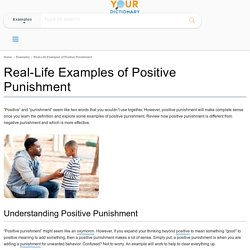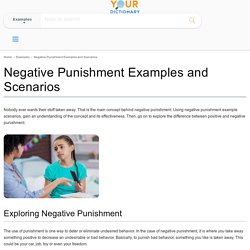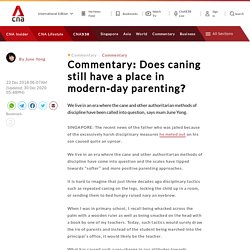

Positive punishment. Negative punishment. Positive Punishment: What It Is, Benefits, and Examples. Positive punishment is a form of behavior modification.

In this case, the word “positive” doesn’t refer to something pleasant. Positive punishment is adding something to the mix that will result in an unpleasant consequence. The goal is to decrease the likelihood that the unwanted behavior will happen again in the future. This approach may be effective in certain circumstance, but it’s only one part of the equation. Guiding your child toward alternative behaviors that are more appropriate to the situation are also needed. Positive Punishment in Operant Conditioning [Definition & Examples] Positive punishment is often used in life when we want to suppress unwanted behavior.
![Positive Punishment in Operant Conditioning [Definition & Examples]](http://cdn.pearltrees.com/s/pic/th/punishment-conditioning-239609851)
Let’s examine its definition, usage and examples, especially when it comes to parenting. What is Positive Punishment Positive punishment is a type of operant conditioning, a theory proposed by psychologist B.F Skinner. Real-Life Examples of Positive Punishment. “Positive” and “punishment” seem like two words that you wouldn’t use together.

However, positive punishment will make complete sense once you learn the definition and explore some examples of positive punishment. Review how positive punishment is different from negative punishment and which is more effective. Understanding Positive Punishment “Positive punishment” might seem like an oxymoron. 12 Examples of Positive Punishment & Negative Reinforcement. You might be thinking that “positive punishment” sounds like an oxymoron, after all, how can punishment be positive?

Not many people “like” punishment, right? The disconnect in understanding this concept comes from the usage of the word “positive;” here at PositivePsychology.com, we generally use the term “positive” to refer to things that are inherently good, things that are life-giving, and things that promote thriving and flourishing. The concept of positive punishment comes from a very different era and a very different perspective on psychology; namely, the 1930s and behaviorism.
Negative Punishment Examples and Scenarios. Nobody ever wants their stuff taken away.

That is the main concept behind negative punishment. Using negative punishment example scenarios, gain an understanding of the concept and its effectiveness. Then, go on to explore the difference between positive and negative punishment. Exploring Negative Punishment. What is Negative Punishment (Examples and Effectiveness) In this article, we will review negative punishment, its definition, examples, and drawbacks.

American psychologist B.F. Skinner developed the theory of operant conditioning, which stated that a person or animal’s behavior could be increased or decreased by adding or removing appropriate stimuli after the behavior is exhibited. Does caning still have a place in modern-day parenting? SINGAPORE: The recent news of the father who was jailed because of the excessively harsh disciplinary measures he meted out on his son caused quite an uproar.

We live in an era where the cane and other authoritarian methods of discipline have come into question and the scales have tipped towards “softer” and more positive parenting approaches. It is hard to imagine that just three decades ago disciplinary tactics such as repeated caning on the legs, locking the child up in a room, or sending them to bed hungry raised nary an eyebrow.
When I was in primary school, I recall being whacked across the palm with a wooden ruler as well as being smacked on the head with a book by one of my teachers. Positive punishment- Caning. Negative punishment- Caning.